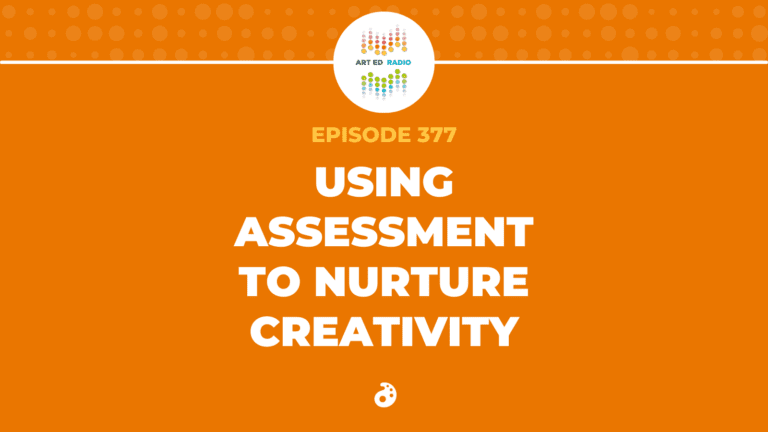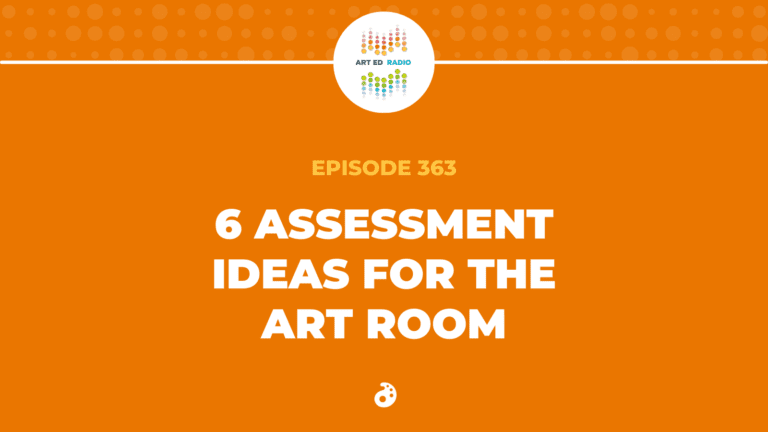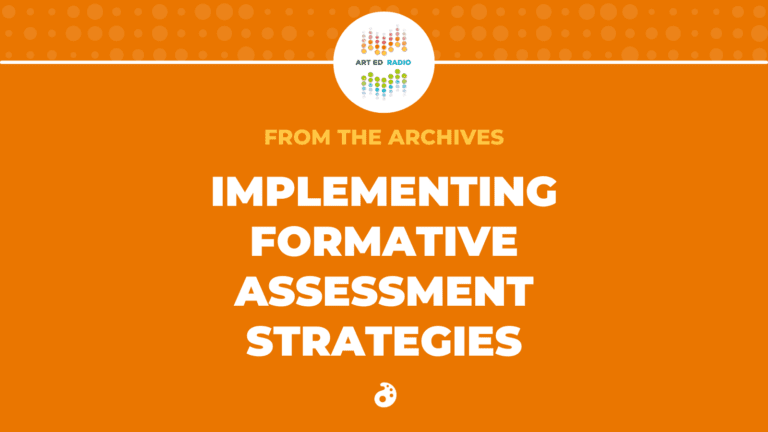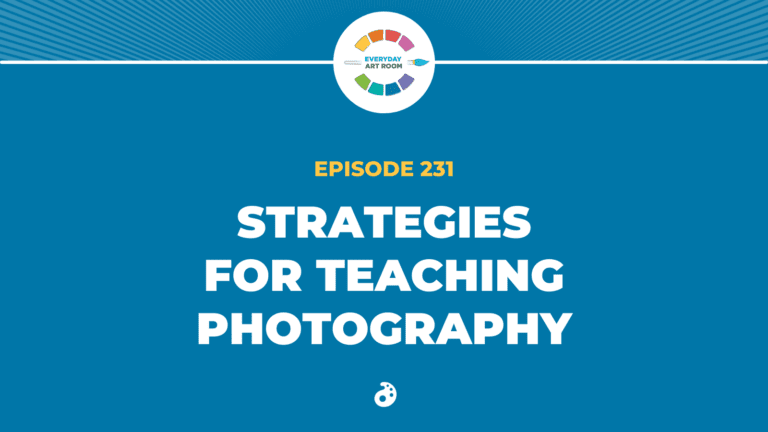Formative assessment is a challenge for most art teachers. How do we know if we are doing it right? How can we do it well without overwhelming ourselves? Lindsey Moss joins Tim in today’s episode to talk about all things formative assessment, including some of her favorite strategies, how you can implement ideas easily, and why assessment should be part of your daily routine. Full Episode Transcript Below.
Resources and Links
- View Lindsey’s new PRO Learning Pack
- Check out the 1-2-3, A-R-T Youtube series
- Listen to Lindsey’s last appearance on the podcast
- Assessments You Can Actually Fall in Love With
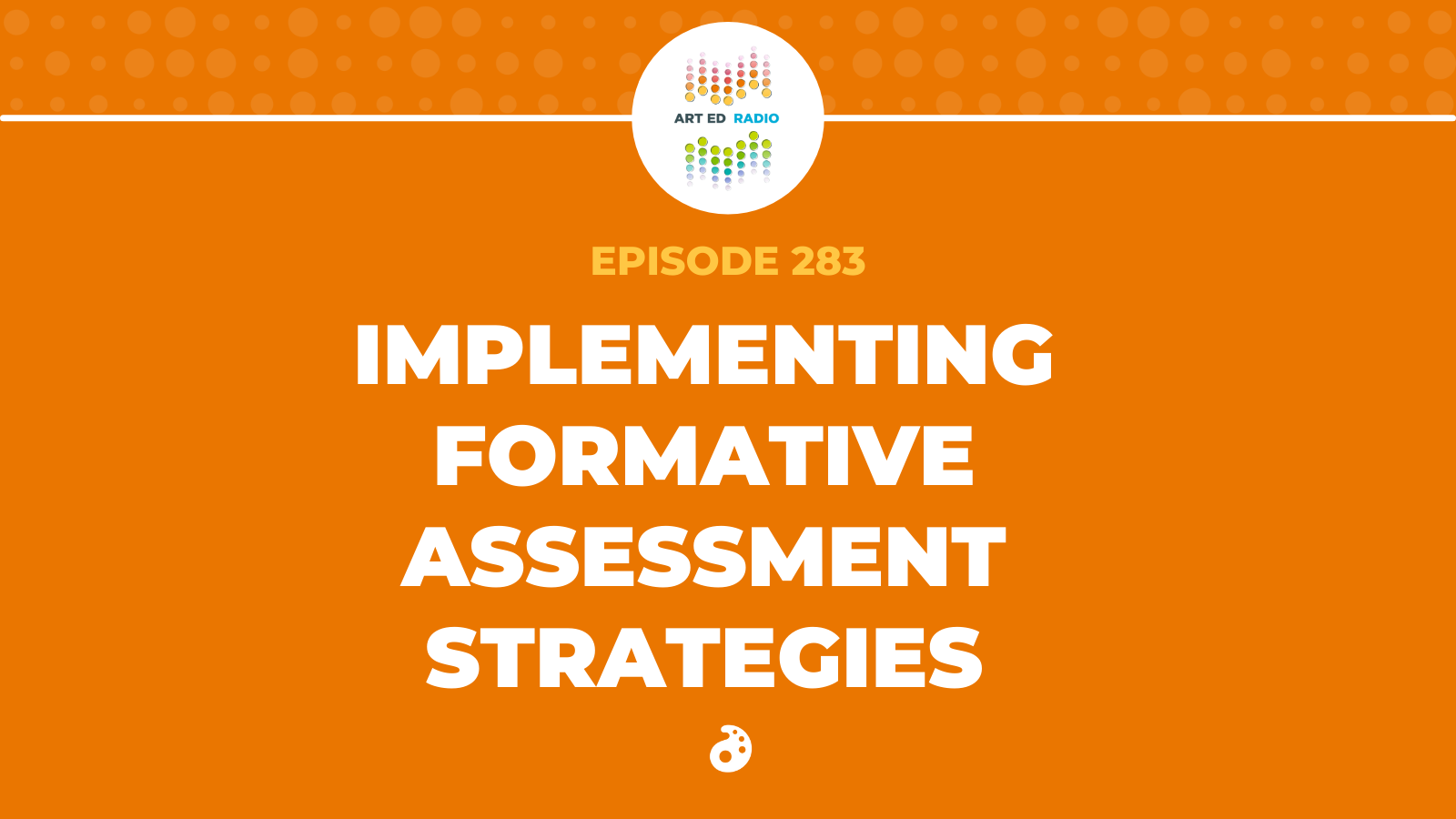
Transcript
Tim: Welcome to Art Ed Radio, the podcast for art teachers. This show is produced by the Art of Education University and I’m your host, Tim Bogatz. As you probably know, AOEU’s PRO learning platform releases new content every single month. And we’re going to have that guide today’s conversation.
We were actually going to do this last week to celebrate the new release, a new pro learning pack. But then we were interrupted by Jay Z and Beyonce and Jean-Michel Basquiat. And that was cool. That was a fun episode, a lot of great stuff to talk about last week. Go listen to it if you haven’t. But today we’re going to get back to the original plan and chat about something even more exciting: formative assessment.
Now Lindsey Moss is going to be joining me today. Her new learning pack that came out last week is called Implementing Formative Assessment Strategies and just like everything else Lindsey does, it is full of incredible information.
She talks about how you can look at formative assessment strategy options and decide which ones are going to work best for you, your students, your classroom. She talks about how formative assessments can easily become part of your daily routine with the emphasis on the easy part of that. She actually makes formative assessment manageable.
And the other thing that I think was cool, she talks about how you can develop formative assessments using peer feedback and using self-assessments as tools, which I kind of wanted to get into a little bit more with her today also, but the entire pack is great. Like I said, Lindsey makes it easy.
She has ideas that will actually work and actually be worth your time. But let’s talk about some of those ideas and let’s talk about why formative assessments are so important to begin with. Let me bring Lindsey on now.
Lindsey Moss is joining me now, Lindsey, how are you?
Lindsey: I’m good. How are you, Tim?
Tim: I’m doing quite well. I’m looking forward to our discussion today. And I guess to start out with, I need you to convince me that I should care about assessment. So I guess for everybody who is listening to this, we think of assessment, we know it’s not glamorous. It’s not a fun part of the job. There’s a lot of negative connotations. I suppose I shouldn’t be quite so negative before we even start, but
Lindsey: I feel like this is an uphill conversation.
Tim: Yeah. I’m sorry. So let me just open it up to you. What do you like about assessment and why do you think it’s important for us as educators to care about assessment?
Lindsey: Okay. So I guess maybe I’m not the perfect guest for this, because I actually don’t really like assessment that much either.
Tim: Okay, well, no, that, that puts us all on an even playing field. I know Janet Taylor she’s been on before. She loves assessment.
Lindsey: Yeah. That’s not me.
Tim: Okay. So let’s, let’s go with just, why, why should we care about it? What does it help us do in the art room?
Lindsey: Okay. So I’m going to, I’m going to put an asterisk here. I do not like general assessment. I don’t like summative assessment. It doesn’t feel super purposeful to me unless you’re really celebrating a kid’s success. But what I like is formative- assessment, because I feel like that is where you can really move a needle on what a kid is learning. Like I think back to my art experience and how many times in my high school or class, I would get something back from a teacher and there would be a score written on the back or a rubric. And I would think to myself, oh, would have been helpful if I had known that.
Tim: Yeah. Or you just get, get it back with a 92 on it. And you’re like, okay, great. And it’s just completely meaningless.
Lindsey: Right. It didn’t really, it didn’t really help drive the process at all. And also you’re probably not going to do that, accept that exact same project again ever, you know? So, so how did that help? And then, I mean, we all have like those moments I think in that are formative in our educational, our understanding of who we are as art teachers and mine was my freshman year of college.
I was in a drawing class and it was taught, it was like drawing one and it was taught by TA. I will not share his name, although it was seared in my brain until I die. And I was from a really small central Illinois farm town and my high school art class, while it was great, it was maybe not as rigorous as some people’s. And so my aesthetic sense was not as well developed maybe.
And so this TA assigned us some absurd number of charcoal drawings of negative space, of still lifes. And I didn’t really understand negative space because I hadn’t been taught and I also didn’t have experience with charcoal. So I was back in my dorm room and I was like a ship without a compass and I did like four of them. And then when you’re uncomfortable, you revert to what you know.
So I got out neon chalk, and I was trying really hard to do negative space in fusion lime green because it just felt better to me. I turned them all in and he wrote on the back of my stack, “Lindsay, your art makes me sick. Never do this again.” Yeah. And it was, it was a lie, I was, I was a baby, I was like 18 or 19.
And I remember having like maybe a moment of clarity there that this was not my fault. I didn’t know how to do this. And if at any point there was a check-in or a conference or feedback that would have steered me in the right direction, I would have learned from it instead of it being a really terrible experience.
So I take that with me as a teacher, because I think so many times we have assumptions about what kids know either because they’ve been in our program for a long time or in a colleague’s program. It’s not always true. Sometimes they know less or sometimes they know a lot more than we think they do. And if you’re not checking in with kids, you’re missing the opportunity to really have them grow. Yeah. So I think formative assessment’s the best way to do that.
Tim: Yeah. Absolutely. So let me ask you this then. Well, first of all, I’m sorry you went through that. That sounds like just a ridiculous experience.
Lindsey: Yeah. It’s okay. It makes you stronger, right?
Tim: I think so. I can tell that a lot of years later, it still, it still stings. [crosstalk 00:07:06]
Lindsey: It still, it still stings. Yeah.
Tim: So let me ask you though, for people who don’t do a lot of formative assessment or maybe looking to do more, what are just some basic strategies that you think people can start with or, or easy ways to get started with formative assessments?
Lindsey: Sure. So, there’s an art’s administrator that we’ve had on for pro and you probably have talked to him on the podcast, Nick Gehl.
Tim: Yes. Love Nick.
Lindsey: I love Nick so much. And he said a couple of things to me over the years that have kind of stuck with me. But the one that I love that Nick said was “formative doesn’t mean formal.” And I think like a lot of times that’s where people get really hung up, that it needs to be a pre-test or some really formal paper and pencil heavy thing.
But I don’t think that has to be the case at all. And I think a lot of people are doing informal formative assessment. They just don’t really realize it. And maybe by being a little more mindful or intentional about that, you can really help kids. So I teach elementary and there’s a whole host of techniques that you can use.
There’s informal assessment that teachers give to students. But another really powerful tool is student-to-student informal assessment. When you can have kids talking to one another and giving them suggestions for how to improve their work. But one really basic thing that I do, I have cups that I bought at a party store.
I have a huge party pack of red, yellow, and green solo cups and you can put them on a table. Because I feel like with little kids if they aren’t sure how to proceed with something, then they’ll, they’ll just quit. Right? And it’s good to, it’s good to have them be a little more metacognitive about their understanding and their process. So I give them a stack of cups. And if you have your green cup on the top of the stack, it means everything’s cool, you can continue.
Yellow is, I might need your help when you have a minute. And red is, I’m just going to sit here until you get to me. And that’s, I think the kinesthetic movement of the cups is really fun for them and they like having that signal. And then they also aren’t waiting with their hand in the air during a project. They can feel like you’re going to scan the room and come see them. So that’s kind of simple.
But I mean there’s a lot of oldies but goodies. Exit tickets? I’m not as big on exit tickets because to be totally transparent, I don’t, I have so many kids I don’t have a lot of time to review those outside of class. So my formal assessment tends to happen like live and in the moment. Like, fist to five, how well do you understand this? Five fingers if you could teach somebody else, three, if you feel like you’ve got it, zero, if you don’t even remember you’re in art class.
So those things seem really basic but when you make them, I think, part of the everyday rhythm of your art room, you kind of normalize asking for help, asking for clarification, relearning and emphasizing process. So it’s less about when a kid is all the way done, what they’ve made, and more about the journey getting there and being a guide for them.
Tim: Yeah. Absolutely. Okay. So there was a lot there.
Lindsey: Sorry.
Tim: No, no, I love all of it.
Lindsey: Everyone, go buy cups.
Tim: Yes. That is the takeaway from the episode today. I have two things specifically in there that I want to ask you about. First is the peer-to-peer strategies assessment. Can you sort of give a couple more examples of what that looks like in your art room? Like how you do that peer-to-peer assessment?
Lindsey: Yeah. Sure. So, I feel like I should put a little bit of a warning on that. It’s, in order to have really succ-successful peer to peer formative assessment, you really have to have set up a classroom culture where kids are okay, giving and receiving criticism. And I think the younger they are, the harder that is to initially start.
And once you kind of got a regular practice of that going, it gets easier over time. But I think in order to set that up, you need to have some really transparent conversations with your kids about SEL, about social emotional learning. And you really have to model for them what a good conversation looks like. And it can’t just be criticism.
So I think probably educators are familiar with some of these structures where it’s a hamburger. You give a hamburger bun of something that was really great and then the meat is something you would change and then the bun is another really great compliment. Or, I think another powerful phrase for kids is, “I wonder.” So when you’re talking about somebody else’s art, you’re not saying, “I think you should change…” or, “I don’t like this.” You’re saying, “I wonder what this would look like if you X, Y, or Z.”
But, the fact that this is all formative, I think is helpful too, from the social emotional learning component, because I think it’s less threatening because it’s not a finished project. Kids aren’t as invested. And so these conversations need to happen more during a planning phase. So you have kids commenting about each other’s thumbnails or preliminary sketch, so there’s still time to change it.
Right? So it’s not somebody saying, “I thought your project could have had more XYZ.” And you’re just kind of left thinking, well, that would have been good to know. Right? It’s happening so early in the project that a kid could, if they wanted to still change the trajectory of what they’re making. That’s not to say they always do, but sometimes they do. So.
Tim: Okay. And then the other thing I wanted to ask you about was just how you do all of this at the elementary level and where people have 300 or 400 or 600 kids? You talked a little bit about just the simple things, like, the fist to five and things like that, that worked. But do you have a couple of other ideas on how people can get started or strategies that are manageable when you’re seeing so many different kids?
Lindsey: Sure. I think when you have big class loads, less is more. So if you introduce one strategy to all the kids and they get kind of familiar with it, it’s the same idea, like why you don’t rearrange your arts supplies in the middle of the year because they can’t be independent and do it on their own. If you teach them just one or two of these, I think that it becomes more manageable.
So, yeah. Having a whole arsenal of 40 different forms of assessment ideas is great. But when you’re dealing with little kids, if you can just pick one or two you like, teach that to the group, then over time they become more comfortable with it and there’s less and less you need to solve as a teacher logistically and more and more they can give constructive feedback that’s actually helpful.
So I think it’s something that builds over time. So it’s not something that is going to come intuitively to kids the first couple of times you do it. But over the course of the school year, I would say usually by about third quarter, it’s kind of a well-oiled machine. But it does take a little bit of time.
Tim: Yeah. Fair enough. Yeah. Everything you want to do with 500 kids, take some time. So, that’s difficult.
Lindsey: But the thing you remember too though is, when you have kindergarten through, I have kindergarten through sixth grade, for the bulk of those kids, it’s not the first time they’ve heard it. Because once you’ve had them as a kindergarten or first grader, then you got second and third graders who’ve done it a couple of times. So, the first year is the hardest, but it’ll get easier from there.
Tim: Yeah. Yeah. And then one other thing that I’m just curious about is when, when I’m teaching at the secondary level, I have kids do a lot of self-reflection. I mean, we do the peer critiques, we have a lot of conversations between the students and myself, but I also ask them to do a lot themselves. Can you, or do you do that at the elementary level? Are there self-evaluation strategies that you put into work? Can you do self-evaluation assessments with the elementary level? And what does that look like if you are doing that?
Lindsey: Yeah. I feel like for me, that’s pretty much, that’s my older kids. That’s like fifth or sixth grade. I don’t know. To me that seems like higher-level thinking because it’s easier, I think, to look at somebody else’s work and imagine a different direction or a next step they could take.
But when you are so immersed in your own work and your own planning, sometimes it’s harder to see the forest for the trees. And so, especially with elementary, I think self-assessment, or self formative assessment is really important, but a lot harder to teach.
And so, I mean, if I was going to share one way I kind of do that with my fifth and sixth graders, I would say that goal setting is maybe a more palatable way to introduce that to them. Cause sometimes it’s really hard if you’ve come up with a bunch of thumbnails for a project, as a fifth or sixth-grader, and you’re trying to self-reflect and informatively make some decisions without peer feedback.
But I think goal setting makes, makes more sense in that lens. If you’re thinking about a goal for your artwork and then answering whether or not this particular thumbnail or this particular sketch answers that goal, that’s maybe a good way to start them on the path to thinking about that critically.
Tim: Yeah. That’s really, really good. Okay. So Lindsay, thank you so much for chatting with me about all of this. I know it’s a big topic and it’s tough for, for people to do, but we appreciate the advice. We appreciate all the strategies. So, thank you.
Lindsey: Yeah. Thanks for having me.
Tim: A wonderful conversation with Lindsey as always. If you want to hear more from her, check out the learning pack on implementing formative assessment strategies. We’ll link to that, of course, but also check out the YouTube kindergarten series. Lindsay was on the podcast here last month, talking about, talking about a lot of things, but specifically how we’re going into this year, dealing with kindergartners and first graders who had never seen the inside of a classroom before.
So because we’re all sort of facing that dilemma, maybe not sure how to handle that, Lindsay put together some incredible content for YouTube. It’s called 1-2-3, A-R-T, and you can find it on AOEU’s YouTube channel. We’ll make sure we link to that as well. And I don’t mean to make this entire episode, go watch this, then go watch this. But I really do think that all of the things that Lindsay has put together are really helpful and really worthwhile.
So take a look at the pro learning pack, check out the YouTube series or pass along the YouTube series to someone who needs it this year. If you’re not teaching kindergarten, I’m pretty sure you know someone who is and maybe share that with them. Because I think it will be really helpful for them. But between all of that, hopefully you can find some good ideas to bring back to your classroom and make your classroom run a little bit more smoothly this year.
Art Ed Radio is produced by the Art of Education University with audio engineering by Michael Crocker. Thank you for listening. We will talk to you next week.
Magazine articles and podcasts are opinions of professional education contributors and do not necessarily represent the position of the Art of Education University (AOEU) or its academic offerings. Contributors use terms in the way they are most often talked about in the scope of their educational experiences.
